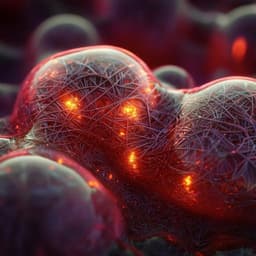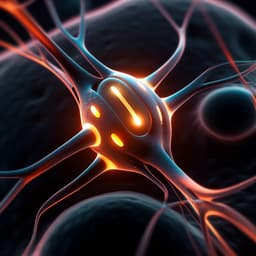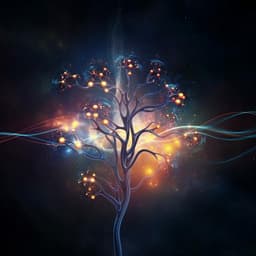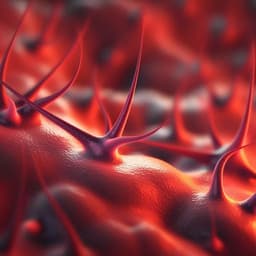
Medicine and Health
Biofeedback electrostimulation for bionic and long-lasting neural modulation
F. Jin, T. Li, et al.
This groundbreaking study, conducted by researchers including Fei Jin and Tong Li, unveils a wearable neural stimulation system that addresses the challenges of invasive electrical stimulation. By harnessing respiratory motion, it adapts biomimetic pulsed electrical signals to enhance nerve regeneration and motor function, offering a promising alternative to traditional treatment methods.
~3 min • Beginner • English
Introduction
Conventional invasive electrical stimulation (IES), while promising as a bioelectronic medicine for disorders such as peripheral nerve injury (PNI), Parkinson’s syndrome, and hysterical paralysis, often leads to excessive charge accumulation at cell membranes. This produces neural stimulus-inertia, with complications including inflammation, immune rejection, pain, and even inhibition of nerve growth. In contrast, endogenous electro-neural signals are inherently self-adjusted, do not trigger stimulus-inertia, and mediate communication among excitable cells to support neuronal network maturation. The authors hypothesize that external electrostimulation that biomimics the self-adjusted nature of endogenous responses can dynamically match physiological needs, eliminate stimulus-inertia, and enable long-lasting activation of nerve regeneration. Building on electromechanical nanogenerators that convert biomechanical deformations into pulsed electrical signals, the study presents a wearable neural IES system: a triboelectric/piezoelectric hybrid nanogenerator-based elastic bioelectronic bandage that captures respiratory motion to generate Bio-iES signals synchronized with vagal and phrenic nerve activity, integrated with an implantable conductive, biodegradable multi-functional nerve guide conduit (MF-NGC). The goal is dynamic, biofeedback-driven modulation of voltage-gated calcium channels (VGCC) to sustain Ca2+-dependent signaling and accelerate nerve regeneration and functional recovery, benchmarked against autograft in a long-segment (15 mm) sciatic nerve defect model.
Literature Review
The paper situates the work within: (1) limitations of conventional IES causing neural stimulus-inertia due to constant, exogenous charge accumulation; (2) the role of endogenous, physiologically self-adjusted neural signals in safe, effective neuromodulation; (3) advances in electromechanical nanogenerators (triboelectric and piezoelectric) enabling conversion of physiological motion into pulsed bioelectric signals and prior applications in biofeedback therapies; (4) nerve guide conduit designs and conductive biomaterials to support nerve regeneration, including PEDOT, polypyrrole, graphene-based scaffolds, and PCL-based conduits; and (5) electrical stimulation’s capacity to activate Ca2+-dependent pathways (e.g., TrkB/BDNF) that upregulate regeneration-associated genes, neurotrophic factors, and promote Schwann cell recruitment, myelination, and angiogenesis. Prior constant-amplitude stimulation often fails long-term due to stimulus-inertia, highlighting the need for dynamic, physiologically coupled stimulation paradigms.
Methodology
- System design: A wearable elastic bioelectronic bandage incorporating a triboelectric/piezoelectric hybrid nanogenerator (TP-hNG) is engineered to harvest vagus nerve-controlled respiratory motion and generate biomimetic pulsed Bio-iES signals. The bandage elasticity modulus is tuned to ~7 MPa to match skin stiffness, with adjustable tightness via mini-buttons for reliable contact with the diaphragm.
- TP-hNG construction and optimization: Negative/positive friction layers use electrospun PVDF piezoelectric nanofibers and polypropylene electret nanofibers, respectively, to maximize electron transfer. PVDF provides a piezoelectric field during compression/release, enhancing electromechanical coupling. A mechanically asymmetric structure (outer hard PET support/envelope and inner flexible PDMS) ensures sufficient contact/separation. Finite element analyses (FEA) model potential generation.
- TP-hNG characterization: Simulated respiratory pressures (1–5 kPa) and frequencies (0.5–3 Hz) are applied via an automatic reciprocating motor. Outputs are assessed for stability, linearity (voltage vs pressure), frequency dependence, and durability (36,000 cycles). Sensitivity to ultra-weak deformation (water droplets, human breath) is evaluated.
- Physiological synchronization assessment: In adult Sprague–Dawley rats, simultaneous recordings of tidal respiratory curves (tension transducer), vagus and phrenic nerve potentials (electrodes), and Bio-iES outputs (oscilloscope) assess real-time frequency and amplitude correlations. Linear regressions between Bio-iES Vpp and nerve potential amplitudes quantify coupling.
- In vitro cellular stimulation: Primary motor neurons are cultured on conductive mats. Three stimulation paradigms are applied for up to 4 days: Bio-iES (respiration-derived, variable amplitude/frequency with day-night variation), square-wave iES (Sw-iES), and triangular-wave mimicking Bio-iES waveform but constant parameters (Tw-iES). Whole-cell current-clamp recordings assess action potential maintenance at 0 h and 48 h. Intracellular Ca2+ levels are tracked over 4 days. Neuronal maturation is evaluated by Tuj1/Map/DAPI triple immunofluorescence; mean axon length and relative expression levels (Tuj1, Map) are quantified (n=5).
- MF-NGC fabrication and characterization: The implanted multi-functional nerve guide conduit comprises aligned core–shell chitosan/PEDOT nanofibers (inner conductive layer) and porous PCL (outer support, average pore size ~3.5 μm). CS/PEDOT nanofibers are made by coating deprotonated electrospun chitosan with PEDOT:PSS followed by H2SO4 treatment to remove PSS and induce PEDOT recrystallization (enhanced [100]/[010] peaks). Core/shell thickness ~17±4 nm. Conductivity, electrochemical stability (cyclic voltammetry), biodegradation, in vivo biocompatibility (CD68, TNF-α immunostaining at 1, 4, 8 weeks), and mechanical properties (elastic modulus ~86.3 MPa) are evaluated.
- In vivo implantation and signal delivery: A 15 mm sciatic nerve defect is created and bridged using the MF-NGC sutured to both nerve stumps. The bandage is worn on the abdomen; soft Pt wires connect bandage to MF-NGC. Bio-iES signals at conduit ends are recorded in different physiological states (walking, calm, anesthesia at 1% isoflurane, deep anesthesia at 1.5%). FEA estimates electric field distribution along the conduit. Long-term output stability is monitored over 14 weeks. Control groups receive Sw-iES and Tw-iES at constant 1.5 V, 1.5 Hz.
- Histology and molecular assays (3 months): Regenerated nerve morphology is assessed by HE and toluidine blue staining; ultrastructure by TEM. Myelination and axonal markers (MBP, S100; NF200, Tuj1) are quantified via triple immunofluorescence. Calcium-dependent signaling is probed with C-fos and BDNF immunofluorescence. Angiogenesis is evaluated by VEGF and CD34 immunofluorescence, CD31 immunohistochemistry; microvessel density and CD31-positive area are quantified.
- Functional recovery: Gait analysis provides sciatic function index (SFI). Electrophysiology records compound muscle action potential (CMAP) and nerve conduction velocity (NCV). Gastrocnemius recovery is assessed by wet-weight ratio, Masson staining, and muscle fiber diameter. Autograft (rotated, re-implanted severed nerve) serves as a clinical gold-standard comparator. Statistical analyses are performed with n=5; significance thresholds indicated (*p<0.05 to ****p<0.0001).
Key Findings
- Bioelectronic bandage/TP-hNG performance: Output voltage increases linearly with pressure 1–5 kPa (R²=0.996; slope 3.44 V/kPa). Stable across 0.5–3 Hz; durable over 36,000 cycles without signal fluctuation. Sensitive to ultra-weak deformations, producing 0.1–0.4 V pulses.
- Physiological synchronization: Bio-iES frequency matches respiration (~1.11 Hz). Inspiratory/exhalation phase durations align with respiratory curves and vagus/phrenic peak envelopes. Bio-iES Vpp correlates linearly with vagus (R²=0.91) and phrenic (R²=0.89) potential amplitudes.
- In vitro neural stimulus-inertia elimination: After 48 h, Bio-iES-treated neurons maintain ionic channel activity and action potential firing; Sw-iES and Tw-iES groups lose evoked action potentials. Bio-iES sustains higher intracellular Ca2+ levels over 4 days; Sw-iES and Tw-iES show reductions from day 2, indicating stimulus-inertia. Neurite outgrowth improved: mean axon length Bio-iES 49.4±8.1 μm vs Tw-iES 23.6±3.7 μm vs Sw-iES 26.0±4.9 μm. Higher neuronal protein expression (Tuj1, Map) under Bio-iES.
- MF-NGC properties: CS/PEDOT nanofibers exhibit increased PEDOT crystallinity; conductivity 0.37 S/cm (vs 0.042 S/cm CS/PEDOT:PSS) using only 0.8 wt% PEDOT, outperforming many hybrid biomaterials. Electrochemically stable; biocompatible with inflammation (CD68, TNF-α) returning to normal by 4 weeks. Mechanical modulus ~86.3 MPa; biodegradable.
- In vivo Bio-iES delivery: Output adapts to physiological states (e.g., walking Vpp 1.5±0.4 V, Ipp 0.071±0.02 μA; calm Vpp 1.2±0.1 V, Ipp 0.057±0.005 μA; reduced under anesthesia/deep anesthesia). FEA shows symmetric axial electric field distribution from ~1.0 V/cm to 0.127 V/cm across states, providing oriented cues for regenerating nerves. Signals stable over 14 weeks.
- Nerve regeneration and myelination (3 months): Regenerated nerve diameter larger with Bio-iES (2.17±0.21 mm) and autograft (2.22±0.26 mm) vs Sw-iES (1.38±0.15 mm) and Tw-iES (1.47±0.18 mm). HE/TB/TEM show abundant Schwann cells and thicker myelin sheaths in Bio-iES and autograft groups. Myelin markers: MBP and S100 in Bio-iES are 3.85× and 3.18× Sw-iES, approaching autograft. Axonal markers: NF200 and Tuj1 are 2.58× and 3.42× Sw-iES.
- Ca2+-dependent signaling: Bio-iES elevates C-fos and BDNF expression to 2.83× and 4.34× Sw-iES, respectively, and 1.66× and 1.98× autograft, indicating sustained activation of regeneration-associated pathways (TrkB/BDNF) without stimulus-inertia.
- Angiogenesis: VEGF expression 3.48× Sw-iES. CD34 expression 4.47× Sw-iES, 4.25× Tw-iES, 1.1× autograft; increased microvessel density. CD31-positive area higher in Bio-iES (3.22 mm²) vs Sw-iES (1.53 mm²), Tw-iES (1.65 mm²), and autograft (2.64 mm²), indicating robust neovascularization.
- Functional outcomes: Gait SFI: Bio-iES −43 vs autograft −40 (better than Sw-iES −51; Tw-iES −53). CMAP: Bio-iES 3.7 mV vs autograft 4.1 mV vs Sw-iES 2.5 mV vs Tw-iES 2.3 mV. NCV: Bio-iES 36 m/s vs autograft 39 m/s vs Sw-iES 24 m/s vs Tw-iES 19.5 m/s. Gastrocnemius: Bio-iES avoids amyotrophy; muscle fiber diameter 62±2.7 μm (autograft 61±2.3 μm; Tw-iES 39.4±3.8 μm; Sw-iES 39.6±2.9 μm); improved wet-weight ratio and Masson staining.
- Overall: Bio-iES eliminates neural stimulus-inertia, enabling long-lasting, physiologically synchronized neuromodulation that matches or exceeds autograft outcomes in long-gap PNI.
Discussion
The study demonstrates that biomimetic, respiration-synchronized Bio-iES pulses dynamically modulate VGCC opening/closing, maintaining membrane excitability and sustained Ca2+ influx. This prevents the exogenous charge build-up and depolarization plateau responsible for neural stimulus-inertia observed under constant-amplitude square or triangular wave stimulation. Consequently, Ca2+-dependent regeneration pathways (e.g., TrkB/BDNF) remain active over months, enhancing Schwann cell recruitment, axon growth, myelination, and angiogenesis. The MF-NGC provides a conductive, biodegradable, mechanically supportive conduit that effectively delivers Bio-iES to the defect site and orients electric fields and neurotrophin accumulation. In a rigorous long-gap (15 mm) rat sciatic nerve model, Bio-iES achieves structural and functional recovery comparable to or exceeding autografts, and significantly superior to conventional iES paradigms. These findings address the core problem of stimulus-inertia that limits long-term neuromodulation efficacy, offering a biofeedback-driven strategy that adapts to physiological states and supports durable neural repair.
Conclusion
This work introduces a wearable, biofeedback neural IES platform that converts autonomic respiration into physiologically synchronized Bio-iES signals and delivers them via a high-conductivity, biodegradable MF-NGC to long-gap peripheral nerve injuries. The system eliminates neural stimulus-inertia, sustaining Ca2+-dependent signaling and markedly improving nerve regeneration, angiogenesis, and motor functional recovery to autograft-like levels. The approach represents a significant advance toward bionic, long-lasting neuromodulation and suggests broad applicability to nervous system disorders beyond PNI. Future efforts should focus on optimizing fully implantable, leadless or wireless implementations to enhance clinical practicality and patient comfort, and on translating and validating the approach across different injury models and species.
Limitations
The in vivo delivery used percutaneous leads to connect the wearable bandage to the implanted conduit, which can cause patient discomfort and mild complications; clinical practicality requires optimization toward fully implantable systems. Results are demonstrated in a rat sciatic nerve long-gap model; broader translational validation in larger animals and diverse neurodegenerative conditions is needed.
Related Publications
Explore these studies to deepen your understanding of the subject.







